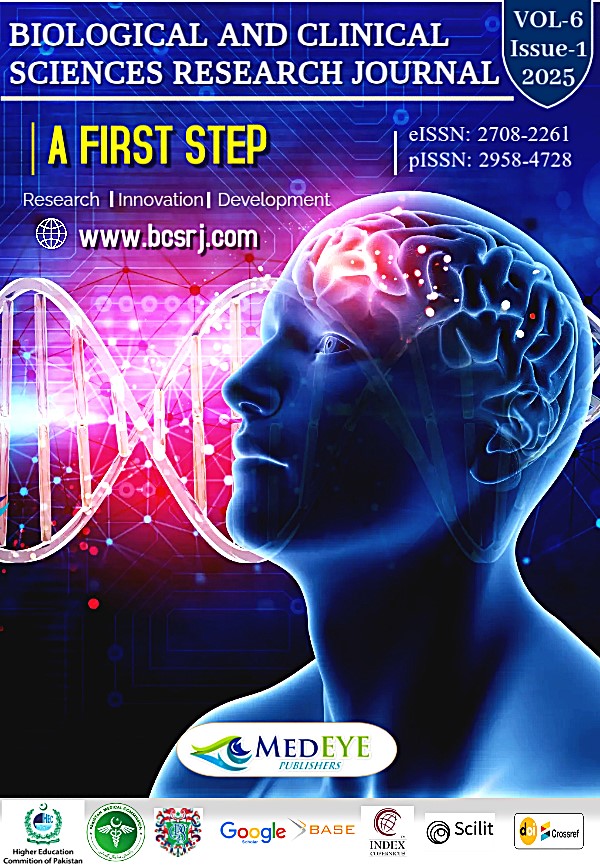Frequency of Newly Diagnosed Diabetes Mellitus in Patients Presenting with ST-Elevation Myocardial Infarction
DOI:
https://doi.org/10.54112/bcsrj.v6i1.1543Keywords:
Diabetes Mellitus Myocardial Infarction Hypertension Metabolic Syndrome Risk Factors IntroductionAbstract
Diabetes mellitus (DM) and myocardial infarction (MI) are two prevalent and closely related conditions that significantly contribute to global morbidity and mortality. Objective: The study also assessed the incidence of recurrent MI, heart failure, and long-term complications in both diabetic and non-diabetic groups. Methodology: This cross-sectional observational study was conducted at Ziauddin Hospital Clifton, Karachi from January 2024 to September 2024. A total of 240 patients were added in the study. Data included demographic details such as age, sex, ethnicity, and medical history. During data collection, the team obtained clinical presentation information through symptom display observation and monitoring of symptom start times, together with the analysis of established MI risk factors, that included hypertension, tobacco use, and heart disease heredity. Results: A total of 240 patients were added in the study, with a mean age of 64.2 ± 9.1 years, compared to 56.3 ± 10.0 years in the non-diabetic group. Hypertension was more prevalent in the diabetic group (90%) compared to the non-diabetic group (70%), while smoking was also higher in the diabetic group (60% vs. 45%). The diabetic group had a higher mean BMI (30.1 ± 4.3 kg/m²) and a significantly higher prevalence of metabolic syndrome (80% vs. 40%). Patients diagnosed with newly onset diabetes were significantly older, with a mean age of 64.2 ± 9.1 years compared to 56.3 ± 10.0 years in the non-diabetic group (p < 0.01). Hypertension was more prevalent in the diabetic group (90%) compared to 70% in non-diabetic patients (p < 0.05), indicating a strong association between high blood pressure and the development of diabetes post-myocardial infarction. Conclusion: It is concluded that while diabetes is not directly responsible for causing ST-Elevation Myocardial Infarction (STEMI), it is a significant risk factor that exacerbates the severity and prognosis of the condition.
Downloads
References
Ding Q, Spatz ES, Lipska KJ, Lin H, Spertus JA, Dreyer RP, Whittemore R, Funk M, Bueno H, Krumholz HM. Newly diagnosed diabetes and outcomes after acute myocardial infarction in young adults. Heart. 2021 Apr;107(8):657-666. doi: 10.1136/heartjnl-2020-317101. Epub 2020 Oct 20. PMID: 33082173; PMCID: PMC8005796.
Ding Q, Spatz E, Lipska K, et al. Screening for newly diagnosed diabetes in young adults hospitalized with acute myocardial infarction-results from the VIRGO (variation in recovery role of gender on outcomes of young acute myocardial infarction patients) study. J Am Coll Cardiol 2020;75:1918. 10.1016/S0735-1097(20)32545-6
Ertelt K, Brener SJ, Mehran R, et al. Comparison of outcomes and prognosis of patients with versus without newly diagnosed diabetes mellitus after primary percutaneous coronary intervention for ST-elevation myocardial infarction (the HORIZONS-AMI study). Am J Cardiol 2017;119:1917–23. 10.1016/j.amjcard.2017.03.016
Aggarwal B, Shah G, Randhawa MS, et al. Patients with newly diagnosed diabetes have comparable long term mortality with known diabetics after ST segment elevation myocardial infarction. Circulation 2018;130.
Lugg ST, May CJH, Nightingale P, et al. HbA1c screening for new onset diabetes following acute coronary syndrome: is it a worthwhile test in clinical practice? J Diabetes Metab Disord 2017;16:14. 10.1186/s40200-017-0296-4
Rathod KS, Jones DA, Gallagher S, et al. Atypical risk factor profile and excellent long-term outcomes of young patients treated with primary percutaneous coronary intervention for ST-elevation myocardial infarction. Eur Heart J Acute Cardiovasc Care 2016;5:23–32. 10.1177/2048872614567453
Ding Q, Funk M, Spatz ES, Whittemore R, Lin H, Lipska KJ, Dreyer RP, Spertus JA, Krumholz HM. Association of Diabetes Mellitus With Health Status Outcomes in Young Women and Men After Acute Myocardial Infarction: Results From the VIRGO Study. J Am Heart Assoc. 2019 Sep 3;8(17):e010988. doi: 10.1161/JAHA.118.010988. Epub 2019 Aug 23. PMID: 31441351; PMCID: PMC6755841.
Bucholz EM, Strait KM, Dreyer RP, Lindau ST, D'Onofrio G, Geda M, Spatz ES, Beltrame JF, Lichtman JH, Lorenze NP, Bueno H, Krumholz HM. Editor's choice‐sex differences in young patients with acute myocardial infarction: a VIRGO study analysis. Eur Heart J Acute Cardiovasc Care. 2017;6:610–622.
Arnold SV, Stolker JM, Lipska KJ, Jones PG, Spertus JA, McGuire DK, Inzucchi SE, Goyal A, Maddox TM, Lind M, Gumber D, Shore S, Kosiborod M. Recognition of incident diabetes mellitus during an acute myocardial infarction. Circ Cardiovasc Qual Outcomes. 2015;8:260–267
Lindholm D, Alfredsson J, Angeras O, Bohm F, Calais F, Koul S, Lagerqvist B, Renlund H, Sarno G, Varenhorst C. Timing of percutaneous coronary intervention in patients with non‐ST‐elevation myocardial infarction: a SWEDEHEART study. Eur Heart J Qual Care Clin Outcomes. 2017;3:53–60
Xue, ZK., Dai, XY., Ren, JY. et al. Prevalence, clinical characteristics, and long-term outcomes of new diabetes diagnosis in elderly patients undergoing percutaneous coronary intervention. Sci Rep 14, 14814 (2024). https://doi.org/10.1038/s41598-024-65426-1
Veronese, N. et al. Prevalence of multidimensional frailty and pre-frailty in older people in different settings: A systematic review and meta-analysis. Ageing Res. Rev. 72, 101498 (2021).
Baber, U. et al. Hemoglobin A(1c) and cardiovascular outcomes following percutaneous coronary intervention: Insights from a large single-center registry. JACC Cardiovasc. Interv. 14(4), 388–397 (2021).
Ostrominski, J. W. et al. Missed opportunities for screening and management of Dysglycemia among patients presenting with acute myocardial infarction in North India: The prospective NORIN STEMI registry. Glob. Heart 17(1), 54 (2022).
Tsuchida, K. et al. Impaired glucose tolerance and future cardiovascular risk after coronary revascularization: A 10-year follow-up report. Acta Diabetol. 57(2), 173–182 (2020).
Tailakh, M. A. et al. Prospective study of the impact of diabetes mellitus newly diagnosed by glycated hemoglobin on outcomes in patients undergoing percutaneous coronary intervention. Eur. J. Intern Med. 37, 69–74 (2017).
Rawshani, A., Rawshani, A. & Gudbjornsdottir, S. Mortality and cardiovascular disease in type 1 and type 2 diabetes. N. Engl. J. Med. 377(3), 300–301 (2017).
Ahmad A, Hussain A, Baig MAR, Arain SA. Diabetes mellitus; prevalence of undiagnosed diabetes mellitus in patients of acute myocardial infarction. Professional Med J 2019; 26(2):299-302.DOI: 10.29309/TPMJ/2019.26.02.31
Downloads
Published
How to Cite
Issue
Section
License
Copyright (c) 2025 Mahnoor Shah, Muhammad Ali Kamran, Noshirwan P. Gazder, Aena Saeed

This work is licensed under a Creative Commons Attribution-NonCommercial 4.0 International License.








